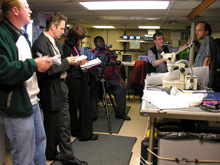
Dr. Steve Ross is interviewed by visitors from the media. Click image for larger view and image credit.
Wilma Eluded, Life on the Edge Resumes
October 26, 2005
Bob Schwartz
Web Coordinator
NOAA Public Affairs
Early this morning, I was awakened by a sound that has become familiar but yet I haven't heard for a while: the sounds of the engines of the R/V Seward Johnson starting up. After two and a half days in port at the old Navy base in Charleston, SC, we are now transiting back toward the Savannah Banks, eager to resume exploring deep coral communities.
Three days ago, high winds, rough seas, and the impending threat of Hurricane Wilma forced the decision to abort our morning dive after only 10 minutes on the bottom. Why not at least finish the dive? According to a member of the sub crew, getting the sub into the water and to the bottom is the easy part, compared to the much more dangerous task of getting it back on the boat. The sub crew has to take all aspects and all four hour of the dive operation into consideration before proceeding. With conditions as they were on Sunday, it was decided that recovery operations would have been too hazardous if they had allowed the dive to continue for the full duration. Five lives are at stake during every submersible recovery (four in the sub and the sub crew's swimmer on top); which is more than enough to put the cost of losing the dive into perspective.
Threatening weather that began on Saturday and our days in port have actually cost a total of eight dives (so far), but it was not a complete loss. While docked in Charleston, we prepared for and conducted a successful media day on Monday, October 24th. The original plan was for the media to take a boat out from Charleston and meet us on station, so our being in port actually made the rendezvous much easier, not to mention safer for our visitors. Live specimens of fish and invertebrates were placed on display in a tank, video footage and color printouts of images taken during our dives and other operations were shown and made available, and GIS models were running that characterized the ocean floor at our dive sites. Dr. Ross and others from the science team made use of these visual aids during interviews as they described the characteristics of the remote fauna we're studying, and the processes associated with acquiring these data.
Visitors also received a unique souvenir: a shrunken styrofoam cup. Styrofoam is full of air bubbles and when it is taken to the depths at which the submersible operates (attached to the exterior of the sub), the air is squeezed out of the styrofoam. As a result, the cup shrinks to a fraction of its size and remains that size, even after ascent to the surface. A shrunken cup is a good visual aid to demonstrate the intense pressure at which the sub operates (in 2000 feet of seawater, we're under 60.6 atmospheres of pressure, or 891 pounds per square inch (psi). The sub's operating limit is around 3000 feet, and at that depth, it's under 91 atmospheres, or 1336 psi).
Aside from media day, we also said goodbye to the members of our team who were only scheduled to stay with us until Monday; these included Liz Baird, Art Howard, Reneé Green and Barb Lubinski. Shortly after hugs and farewells to those teammates, we were being introduced to new teammates who will be taking over their tasks for the remainder of the expedition. These include M.T. Palmer from the North Carolina Museum of Natural Sciences, Doni Angell, a seventh-grade teacher from North Carolina, and Colleen Young, a biologist from the US Geological Survey's Leetown Science Center in West Virginia. Unfortunately, no one will take Art Howard's place, and his talents behind the camera will be sorely missed. Fortunately, we still have Murray Roberts who has volunteered to take on the job of photographing the samples that we collect during the dives. Before Art left, he gave Murray a crash course in close-up photography. Though Art is a tough act to follow, Murray is looking forward to the challenge.
Additionally, our time in port gave us a chance to catch up on organizational matters such as coding data, transcribing audio logs, planning future dives, talking about future science proposals and editing manuscripts: tasks that tend to take a backseat when we're busy diving, sampling and analyzing. Though it cost us some at-sea samples, our time ashore was used well, and provided a fortuitous opportunity for stocking up on supplies, calling loved ones (cell phones don't work offshore) and just feeling some land under our feet. Though the deep coral communities had to be put on hold for a few days, at least we got a chance to do some exploring in Charleston, which is a nice place to be stuck for a few days.
Life on the Edge will be sending daily reports from Oct 16 - Nov 4. Please check back frequently for additional logs from this expedition.


























